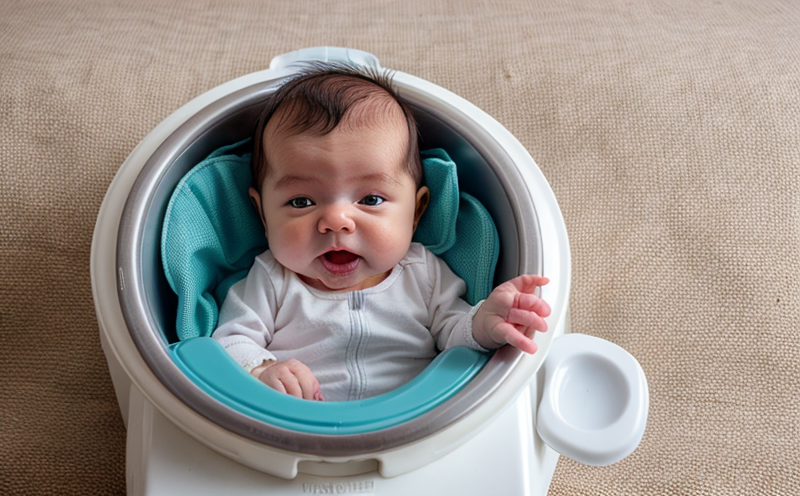ISO 68392 Allergen Residue Testing in Infant Formula
The stringent regulation of infant formula and baby food is of paramount importance to ensure the safety, quality, and nutritional adequacy for vulnerable infants. One critical aspect of this regulation pertains to allergen residue testing, specifically adhering to ISO 68392. This standard is designed to ensure that infant formula does not contain detectable levels of common food allergens. The test aims at safeguarding infants from potential allergic reactions, which can have severe health implications.
Infant formula manufacturers must meticulously follow this protocol to guarantee the absence of allergen residues in their products. This includes not only the primary ingredients but also any trace elements that might inadvertently find their way into the final product. The testing process involves a series of steps designed to ensure accuracy and reliability, from sample collection and preparation to analysis and reporting.
Accurate results are crucial for maintaining consumer confidence in the products, especially given the sensitive nature of infant health. Compliance with ISO 68392 is not just about meeting regulatory requirements but also about demonstrating a commitment to quality and safety. This commitment can significantly enhance brand reputation and trust among parents and caregivers.
The standard specifies detailed procedures for extracting allergens from samples, quantifying them using advanced analytical techniques such as liquid chromatography with mass spectrometry (LC-MS/MS), and ensuring that the results are interpreted correctly. The process is rigorous to minimize false positives or negatives, which could lead to either over-removal of ingredients or allowing harmful residues into products.
The testing protocol requires a comprehensive approach involving multiple steps:
- Sample Collection: Ensuring that the sample collected accurately represents the product being tested. This involves selecting appropriate containers and storage conditions to prevent contamination.
- Preparation: Properly preparing the samples for analysis, which may include dilution or further processing as required by the test method.
- Analytical Methods: Utilizing validated methods such as LC-MS/MS to detect and quantify allergens. This ensures that even very low levels of allergens can be detected.
- Interpretation: Carefully analyzing the data obtained from the analysis, ensuring it meets the stringent criteria set by ISO 68392.
The importance of this testing cannot be overstated. It directly impacts public health and safety, especially for infants who are at higher risk due to their developing immune systems. The results of these tests provide manufacturers with critical data that can inform product development, formulation adjustments, and quality control processes. By adhering strictly to ISO 68392, laboratories contribute significantly to the overall safety and efficacy of infant formula products.
Why It Matters
The significance of allergen residue testing in infant formula cannot be underestimated. Allergens such as milk proteins, soy, peanuts, tree nuts, wheat, eggs, and fish can have severe health implications for infants if not properly managed. The presence of even minute amounts of these allergens can trigger allergic reactions that range from mild to life-threatening anaphylaxis.
Given the critical role infant formula plays in nutritionally supporting vulnerable infants, ensuring its safety is a top priority. Compliance with ISO 68392 not only helps prevent accidental exposure but also instills confidence among parents and caregivers. It underscores the manufacturer's commitment to providing safe products that meet global standards.
The consequences of non-compliance can be severe. Regulatory actions, product recalls, and potential legal liabilities are just a few of the risks faced by manufacturers who fail to adhere to these stringent testing protocols. Moreover, maintaining compliance helps protect brands from reputational damage and enhances consumer trust in the products.
The broader implications extend beyond individual manufacturers and consumers. By ensuring that allergen residue levels are within acceptable limits, the industry as a whole contributes to public health by reducing instances of allergic reactions among infants. This collective effort also sets a precedent for high-quality standards across the food and feed testing sector.
Applied Standards
The primary standard governing allergen residue testing in infant formula is ISO 68392. This international standard provides comprehensive guidelines for detecting and quantifying allergens in food products, with a specific focus on infant formula. It outlines the methods of sample preparation, extraction techniques, and analytical procedures to ensure consistent and accurate results.
ISO 68392 emphasizes the importance of using validated analytical methodologies such as liquid chromatography-mass spectrometry (LC-MS/MS) for allergen analysis. The standard also specifies criteria for acceptance limits based on potential health risks associated with different allergens. This ensures that even trace amounts of potentially harmful substances are identified and managed appropriately.
The application of this standard goes beyond mere compliance; it sets a benchmark for excellence in food safety and quality assurance. By adhering to ISO 68392, manufacturers demonstrate their dedication to producing safe and reliable products. This commitment not only protects infants but also fosters trust among consumers and regulatory bodies.
Environmental and Sustainability Contributions
The practice of allergen residue testing in infant formula contributes positively to environmental sustainability. By ensuring that products are free from harmful allergens, the industry reduces the need for extensive product recalls and potential waste. This minimizes environmental impact associated with manufacturing disruptions and consumer returns.
- Reduction in Waste: Proper allergen testing prevents the release of potentially unsafe products into the market, thereby reducing the likelihood of waste generation due to recalls or withdrawals.
- Economic Efficiency: Avoiding product recalls can save manufacturers significant costs related to rework, replacement, and customer dissatisfaction. This financial stability supports more sustainable business practices.
- Consumer Trust: Ensuring safety builds consumer trust, which is crucial for long-term sustainability of brand reputation. Satisfied customers are more likely to support eco-friendly initiatives.
- Innovation in Testing: The continuous improvement of testing methods and equipment contributes to advancements that can be applied across various industries, promoting innovation overall.
By adhering to ISO 68392, laboratories play a vital role in maintaining the integrity of infant formula products. This not only enhances public health but also supports sustainable practices within the industry.





